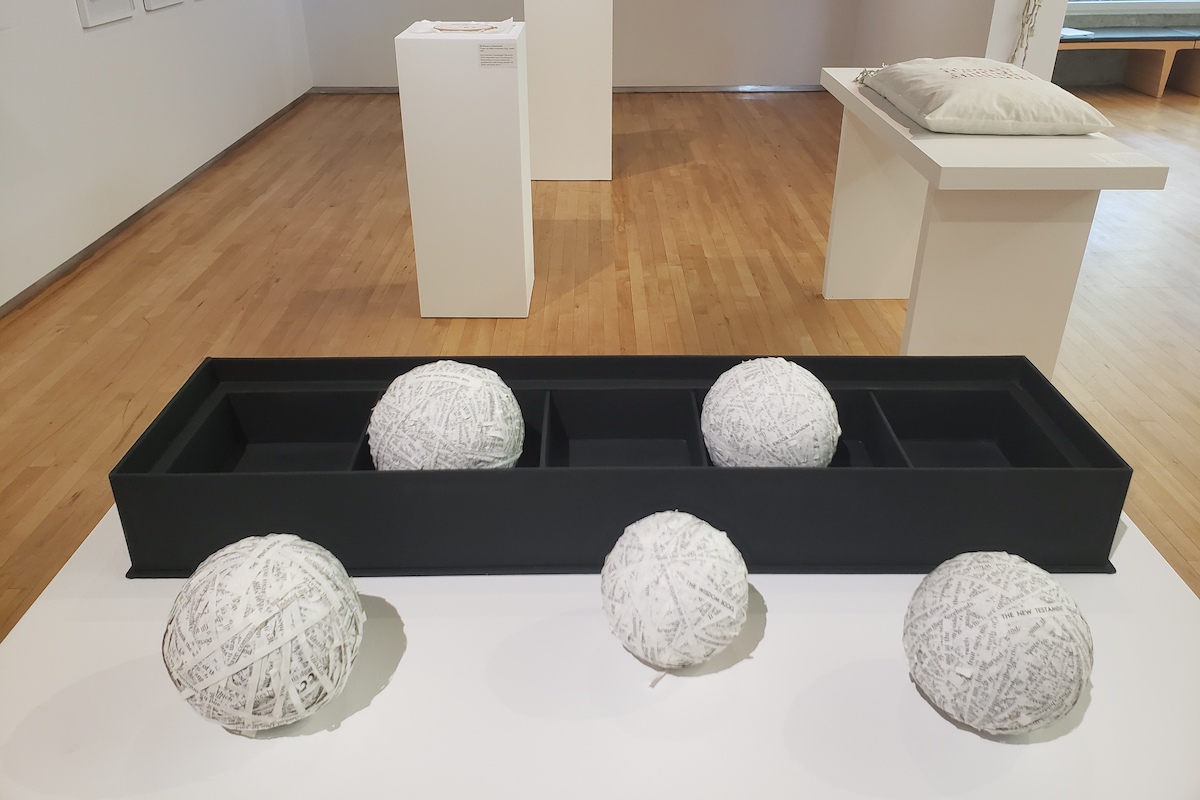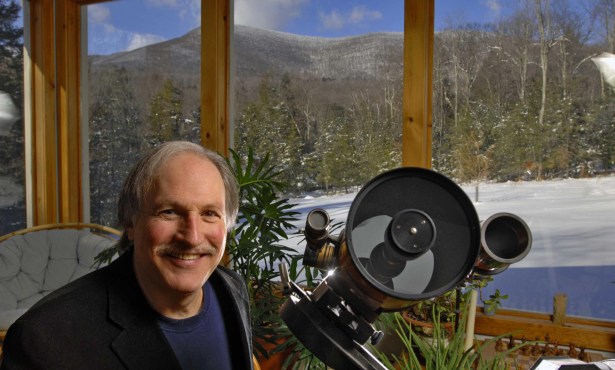Reframing Biblical Text and Context at Westmont’s Art Museum
‘Straddling Circumference,’ a Ripe Retrospective of Linda Ekstrom’s Book Art, Brings Her ‘Altered Bible’ Series to Christian College in Santa Barbara

Conceptualist “book artist” Linda Ekstrom has long been known to have her own personal way with books, to unique artistic ends. A professor at UCSB’s College of Creative Studies for more than two decades, Ekstrom is the subject of a fascinating retrospective exhibition opening the new Westmont Ridley-Tree Museum of Art season, exploring her love of books — including the Bible — and her love of deconstructing the physical objects, fastidiously reshaping pages and minute lines of text. Deconstruction leads to new and tangled meanings.

That latter part of the process has fomented some controversy in the extensive Westmont show, called Straddling Circumference, with some at the Christian college calling foul at the prospect of Ekstrom’s “desecration” of the Holy Bible. Ekstrom has shown her work in various art spaces around town, and beyond, for a few decades, but context matters in a Christian university setting. She stirred controversy over one work shown in a Westmont exhibition in the 1990s — “Sophia’s Logos,” also in the current show. But with this exhibition, the art and the artist stretch out in the full regalia and overview of a Biblical reviser, with intellectual and spiritual seeker credentials in check.
Kudos to the museum’s director and curator Judy Larson for facilitating this deserving retrospective tribute to an important and distinctive Santa Barbara–based artist.
To play devil’s/angel’s advocate, Ekstrom’s “altered Bible” art can be viewed from a very different perspective, as part of a process of contemplation and a personalized “re-secration” of the sacred book, from her own vantage as a feminist, idea-fueled contemporary artist and also as a Catholic. Italian film director Pier Paolo Pasolini ran into similar friction with the church, but his films explored spiritual conflict and inquiry from his viewpoint as a gay, Marxist Catholic. In recent decades, religion-questioning art by Andres Serrano and Chris Ofili has rankled conservatives and engaged discourse on the changing role of the church.
For Ekstrom, the Bible is a living, evolving fount of inspiration, not an inert text with fixed meaning. Just as Biblical scholars and seminarians parse potential meanings and revised references, her artistic means involved interpreting and reexamining the Bible, and exposing the patriarchal nature of the book and religion at large.
That process translates into such literally Bible-based sculptures as “Flourish,” a meticulously cut-up flowering of pages bursting out from its leather cover; or “Chains,” a long chain-like piece with each link made from a single Bible page, invoking the continuum between heaven and Earth. “The Women of the Bible” is a deceptively graceful fabric piece, its long, looping fabric embedded with all female references in the Bible, adding up to a surprisingly lean body of text.

Ekstrom’s list of inspirations goes beyond the Bible, and a modest number of pieces in the show spring from such non-religious influences as Emily Dickinson and female mystics Simone de Beauvoir, Simone Weil, and Teresa of Ávila. The museum’s entrance gallery space includes such extra-bookish pieces as “Labyrinth,” drawings both detailed and a touch chaotic; and “The Long Walk,” linear memory drawings made with her eyes closed to chronicle a walk she once took. They feel like blueprints of circumambulation and the mysteries of memory.
But our attention is mostly attuned to her “altered Bible” art, especially given the prominence of that body of work, and as seen in this space on this campus. Beyond the subject matter involved, Ekstrom’s artistic practice involves an ever-shifting array of inventive approaches to sculptural forms and change-ups. Her often audacious — and for some, button-pushing — ideas are transformed into craft-conscious and cleanly realized art objects.
“Mary and Eve II” depicts these primary female figures in the Bible — Eve as a wayward but sincere seeker of God, and Mary as the holy host who accepted God’s proposition, forwarding the master plan. The powerful duo is represented, with a pinch of pithy wit, in the form of a canning jar with water (holy water, we presume), an apple, and a plastic Mary figurine.
In “Word of Hand,” Ekstrom’s super-fine dexterity comes in handy, having X-acto-knifed all Jesus’s words in the Bible (printed in red in some editions), rolled into tiny balls, and stuffed in a transparent glove. Voilà, a way to grasp Jesus’s words in hand.
If many Biblical pieces are, in fact, subtle and conceptual, the cloistered back corner of the main gallery is more startling: The elaborate “Menstrual Liturgical Cycle” indicts the repressive, diminishing view of women in the Catholic church with neat rows of silk squares referring to the liturgical calendar, with a dab of faded blood on each. The piece makes an impact both dramatic and subversive, with a light hand.
For those of us who have been keeping tabs and admiring teasing glimpses of Ekstrom’s part over the years, the sum effect of Straddling Circumference can amount to a revelation. Yet the revelation is not so much any crafty shock effect, but a long arc appreciation of how her artistic and, yes, spiritual obsessions fit together in a grand design all her own.
Straddling Circumference: The Art of Linda Ekstrom is on view at Westmont Ridley-Tree Museum of Art through November 11. See westmont.edu/ekstrom for details.







You must be logged in to post a comment.